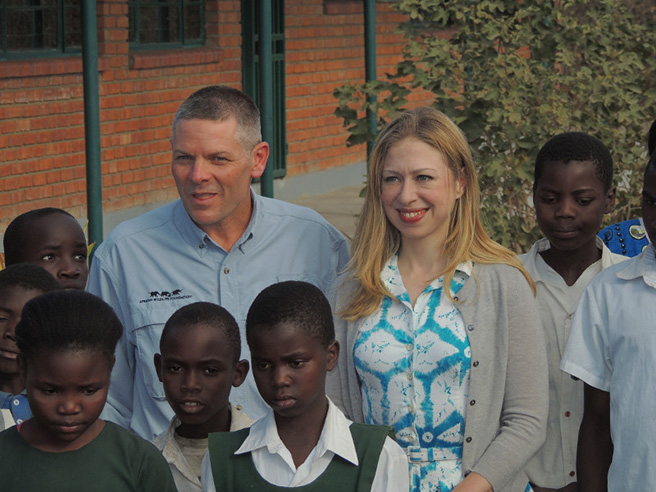Chelsea Clinton Blogs About Africa's Elephant Poaching Crisis and Her Visit with AWF

Earlier this month we shared with you about Chelsea Clinton’s visit to African Wildlife Foundation’s (AWF’s) Kazungula Landscape—a critical area that is home to Africa’s largest elephant population.
Clinton, vice chair of the Clinton Foundation and daughter of President Bill Clinton and former Secretary of State Hillary Clinton, visited two of AWF’s community conservation projects on behalf of the Clinton Foundation.
AWF CEO Patrick Bergin and staff led her on a tour of Lupani Conservation Primary School and Machenje Fishing Lodge, both solutions are intended to provide value to their communities—revenue, education, jobs, etc.—while also providing protection to wildlife, like elephants, sharing living space with people.
Now, in her latest blog, Clinton shares about her experience with AWF and her perspective on the dire state of elephant poaching in her post 'How We Can End the Elephant Poaching Crisis.'
"While elephant poaching has been a serious challenge at different points in time for more than a century, it has recently risen to alarmingly high levels. According to the Wildlife Conservation Society, the African elephant population has dropped from 1.2 million in 1980 to just 420,000 in 2012. While land use pressures and habitat loss pose serious threats to elephants, it is the illegal killing of elephants for their ivory that could cause them to become extinct within our lifetime. Last year alone, 35,000 African elephants were poached for their tusks, for their ivory.
This is not just an ecological disaster; it is an economic and security threat as well. Tourism, a vital source of income for many of the most-affected African countries, is threatened if wildlife preserves are depopulated. The overall black market for illegal wildlife trade has become the fourth most lucrative criminal activity internationally, after drugs, counterfeit goods, and human trafficking. Wildlife trafficking yields $19 billion per year, according to The International Fund for Animal Welfare’s recent report. These illicit profits fuel rebel and militia groups, even terrorist organizations. Ivory and other wildlife commodities help finance some of their operations in East Africa, West Africa, and possibly further afield, adding to the already increasing concerns around global security.
The illegal ivory trade is buoyed by rising demand. China and Thailand’s increasing affluence, as well as the growing middle class elsewhere in Asia, has been a key contributor to the increasing demand for ivory. Not surprisingly, as the demand increases, so too does the price of tusks and ivory and the tragic incentives for elephant poachers. According to a recent Washington Post article, Savannah elephant tusks sell for up to $1,000 per pound, with forest elephant ivory often fetching an even higher price given its prized pinkish hue. Yet, it’s not just animal poaching or the illegal trade of animal parts that has enveloped within this crisis – poachers are putting park rangers in danger too. In the last decade alone, 1,000 rangers in 35 different countries have been killed.
To help end this crisis, we need a complete systems change and we need to recognize that elephant poaching exists within its own market system – we need to stop the killing, stop the trafficking, and stop the demand by educating end consumers. Last November, as then-Secretary of State, my mother announced the beginning of an effort to further recognize and address international wildlife trafficking, and just last month, President Obama issued an executive order on Combating Wildlife Trafficking, with a $10 million pledge demonstrating the United States’ commitment to addressing the crisis and related organized crime issue by working with foreign governments.
Outside of the U.S., other organizations like the African Wildlife Foundation are creating innovative programs to incentivize and reward local populations in the successful protection of elephant populations. The 40,000-hectare Sekute Conservation Area is part of the Kazungula Landscape which links Zambia, Botswana, Namibia, and Zimbabwe, and is home to the largest concentration of elephants in Africa. I recently had the opportunity to visit this conservation area and meet with the students and faculty of Lupani, the community trust leadership, as well Patrick Bergin, the CEO of the African Wildlife Foundation. In Zambia, the African Wildlife Foundation built and continues to support the Lupani Primary School as an incentive for the establishment of a community-protected wildlife area and the protection of valuable wildlife dispersal corridors. They also developed and brokered an innovative deal between the Sekute Community Trust and private sector partners to build the Machenje Fishing Lodge. In return for meeting specified conservation objectives, the local community owns the fishing lodge, while the private sector partners handle the management. Hopefully, it is a true win-win-win, for the private sector partners, the community, and the wildlife.
In Tanzania, I visited one of the parks where the Wildlife Conservation Society does research on elephants and works with the Tanzanian government to protect this species. I think it would be impossible to not be overwhelmed by the majesty, the humility and the personalities of the individual elephants and families of elephants roaming across Tarangire National Park. As I observed a three-month old baby elephant playing mischievously and a thirtyish year old mother protecting her children, it became starkly clear how innocent these creatures are, and how necessary it is for us to protect them. The mother cannot protect her young on her own. I listened as Charles Foley, an elephant conservationist, and James Deutsch, the Director of the Wildlife Conservation Society in Africa, described the successes they’ve had working with governments and communities at protecting elephants on the ground in twelve high priority landscapes from Nigeria to Mozambique – Tarangire included. But they also stressed that this success needs to be rolled out to new sites where elephants are being killed, as well as complemented by work to intercept ivory traffickers and to staunch consumer demand for ivory. They know that they also cannot protect elephants on their own.
In the 1970s and 1980s, the international community successfully came together to prevent the extinction of elephants, an effort that led to an international trade ban of ivory, along with funding to create wildlife preserves and anti-poaching efforts – all of which helped the African elephant population recover. Last month, my mother held a meeting with several conservation groups to discuss how we need to do more, and how we can do more to bring governments, organizations, and individuals together to create a coherent plan and reach a real solution. I’m proud that the Clinton Foundation is beginning to work with African leaders, NGOs and the private sector to build a Clinton Global Initiative commitment to formalize a plan and drive coordinated action. By working together across borders and sectors, we can solve this challenge. "
Read her original blog post on the Clinton Foundation webiste.
Check out her visit in photos.
